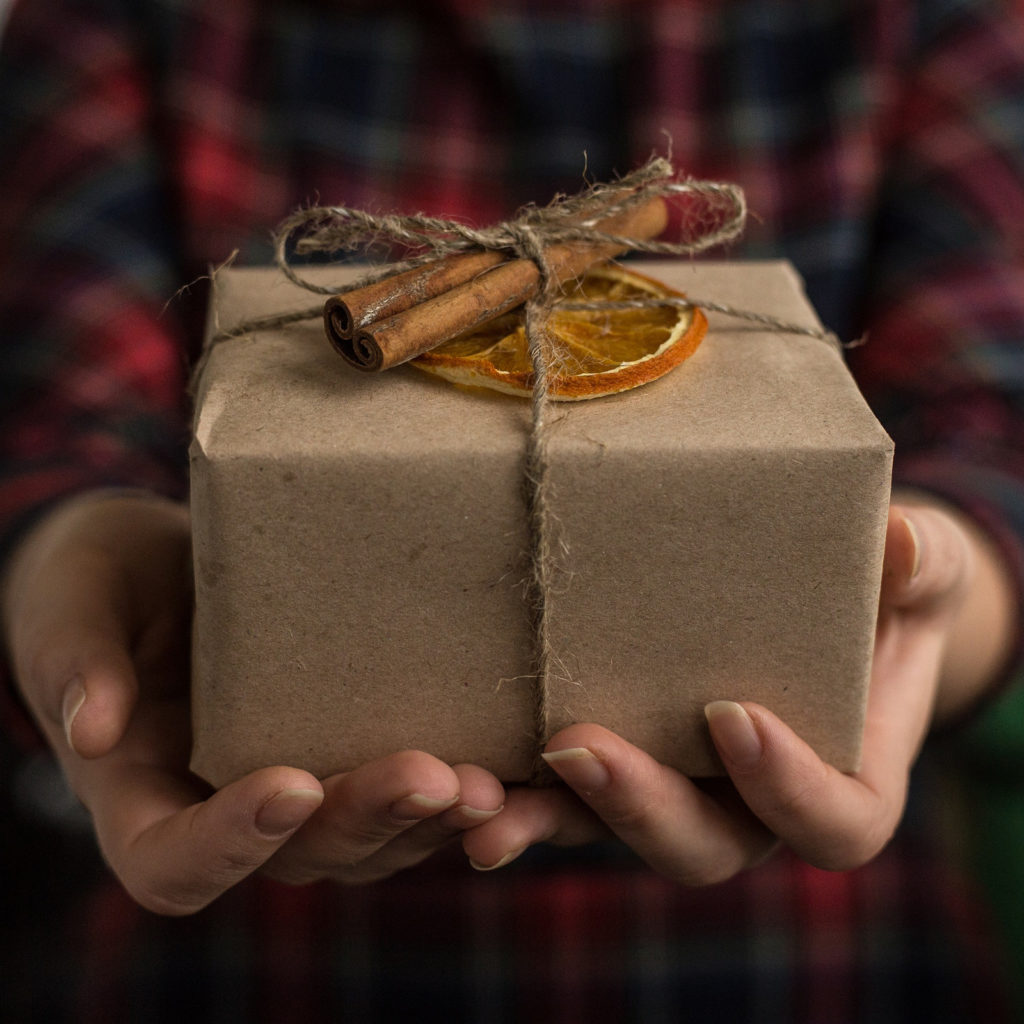
It’s kind of ironic that the day set aside for Thanksgiving ushers in the season for the biggest commercialized holiday in the United States. In spite of all the opportunities to give, Christmas can be a very “me-centered” holiday, especially for children: “What do you want for Christmas?” I hear grown-ups asking children all season long. Writing long wish-lists and anticipating huge piles of presents under the tree are more on the forefronts of most children’s minds than sharing, giving, or writing thank-you notes.
From my childhood reading of A Little House on the Prairie series, I recall how Laura and Mary Ingalls were so excited to receive an orange and a piece of candy for Christmas. Now oranges are readily available in supermarkets year-round, and our society is saturated with cheap candy for every holiday and everything in-between. How far have we come (or how far have we regressed?) that any American child today would be bitterly disappointed with such a Christmas present, or even angry?
When I was young, my family did not celebrate Christmas. At least not officially. As conservative Christians, my parents were conscientious to avoid anything that had pagan roots. And if they were inclined to celebrate Christmas, they didn’t like its commercialization.
However, we DID go to Grandma’s house for an amazing dinner on Christmas day (forming my expectation of what a holiday feast should look and taste like) and spent the rest of the afternoon and evening with family.
My Grandma quietly made sure we children were not left out. After the table and dishes had been cleared from our feast, she sat us down in her living room and handed out a present for each of us. A single present.
When my sister and I were younger, Grandma often sewed us matching flannel nightgowns. When Grandma didn’t sew, she often went to the bookstore to choose a quality picture book with a great story for the younger ones, or the first couple chapter books in a series for me. (Even in her last years when she couldn’t get out, she sent my aunt to the bookstore to bring home a collection of books for her to choose from. She wrote the recipient’s name and signed the inside the cover of each book, for us to remember her.)
Sometimes she deviated from her usual gifts. The Christmas after I turned 10, Grandma gave both my cousin and me a calligraphy set. In a nice box there were three sizes of metal nibs, a whole tray of different colors of ink, and a hollow pen which you screwed together to connect the ink tube to the nib. My cousin and I sat down together and practiced the alphabet in the two or three calligraphy styles portrayed in the directions. That winter, I devoted a lot of time to practicing calligraphy. Over the years, I have used my calligraphy set for many things—designing my own greeting cards, penning a verse to frame with a picture, or other gifts. I still have this set to this day. It remains one of my most treasured Christmas gifts.
I loved Christmas at Grandma’s house. She has been gone for nearly 20 years, but I still have warm memories of a beautiful table laden with homemade foods (including her homemade rolls, homemade strawberry and raspberry jelly, and sweet, tender green Lima beans grown in her own garden). The lazy afternoon was spent putting together puzzles, watching videos about Beatrix Potter in my aunt and uncle’s basement (Grandma lived in an addition to their house), and piling easy sandwich fixings on fancy pewter plates that evening.
And I remember the anticipation of the single, simply wrapped present I would receive from Grandma. I didn’t need any more than that.
The hard part, of course, was being different from everyone else. The following Sunday at church, other friends would boast of all the things they got for Christmas, and then turn to me. “A book ……………” followed by an awkward silence. What mortification to have nothing more to add! One year I got a present from my Grandma, PLUS my cousin gave me a pair of cheerleaders’ pompoms. It felt a little better to list TWO things to my friends that year instead of just one.
The brief awkwardness was hard, but it didn’t ruin me. I didn’t really wish we celebrated Christmas like the rest of America. Maybe I did a little bit occasionally, but I was generally happy with our Christmas day at Grandma’s. And the single present I received.
While in later years my parents loosened their anti-Christmas stance, the changes were not drastic. My mother began setting a festive table for breakfast on Christmas morning, complete with greenery from the woods, and an orange and a candy cane at each place. And they started giving gifts to each of us children. (Still, the gifts were small and not extravagant. More like what other families would consider stocking stuffers.)
After breakfast, my mother would disappear upstairs and return with her arms laden with gift bags bulging with surprises. Socks, snacks, lip balm, maybe some books or other useful or special items, like small things for the girls’ hope chests as we grew older. Sometimes the gifts were items from Goodwill, but that was okay. They were chosen with care for each of us, and we relished unwrapping and savoring the gifts given in love. Gifts we didn’t use to get.
There were six of us children, spanning 18 years. Still, even with the younger siblings, I don’t recall tears of disappointment or complaints of unfairness in any of these Christmases. No matter how small or simple the gifts were, we were happy because we had no expectations.
In contrast to my childhood Christmas experiences, it seems the American way is for families to lavish piles of presents on their children. But then children tend to toss aside one opened present after another for the next with hardly a glance—and no acknowledgement of the giver. And sometimes, children pout or burst into tears upon receiving something that wasn’t as fun as expected. Again, with no regard to the giver.
I don’t want my children so overwhelmed with gifts they can’t truly enjoy any of them. I don’t want them growing up with a self-centered lack of appreciation. I don’t what them forever dwelling in the negativity of discontent.
I’m NOT advocating that nobody should celebrate Christmas, or that parents should never display liberal generosity toward their children. Rather, I believe we should be mindful that our gift-giving practices do not create selfish children or short-circuit their development of gratitude and contentment.
So what do we do in our family? We’re not perfect, and our gift-giving practices and attempts to teach gratitude will probably change over time.
Currently, we don’t spend exorbitant amounts of money on presents. We do try to choose presents that are worthwhile and that will be well-used. We teach children in our home to say “thank you.” We talk about how to say “thank you” and smile even if a gift isn’t our favorite. Because the kindness of the giver is more important than how pleased we are with the gift.
My mother always encouraged (or required) me to write thank-you notes for gifts I received. This is something I intend to do more regularly once our children are old enough to write. The time it takes to send a note forces the writer to focus on the giver.
One year in school I learned a helpful outline that I have used ever since: Start the body of the note with “Thank you for___.” Then explain why you liked the gift, what your favorite thing about it was, or what you plan to do with it. (This could be one or more sentences.) End with “Thanks again for ___.”
What are some other ways to help our children learn gratitude?
- Valuing the feelings of others—Children are naturally self-centered, so we need to help them see the giver’s perspective. Ask, “How would you feel if you were really excited to give Grandma a gift you made, and she didn’t say ‘thank you’? Or she threw it down? Or she complained that it wasn’t nice enough? Etc.” This is why we are kind to others and say “thank you.” We can help by modeling appreciation to our children when THEY do something nice. Then they will know how good it feels to be on the receiving end of appreciation.
- Having humility—Just like with salvation, we don’t DESERVE gifts. People give us gifts because they LOVE us.
- Appreciating the value of money and work—Gifts cost money, so someone worked hard to buy that gift. When children begin to earn and spend money, they will appreciate the value of money more, but parents can still talk about before then. This is also important when teaching children how to take good care of what they have.
- Developing a heart of contentment—Talk about (and demonstrate) how it is okay to not have everything other people do. Practice giving thanks in all circumstances instead of complaining. We all have to work at this.
A friend shared this perspective on instilling thankfulness in our children. I really liked the suggestions for teaching children the four parts of gratitude.
How did you learn gratitude? How do you teach your children gratitude and contentment during the Christmas season? Share your experiences in the comments!













 Push into the Pain
Push into the Pain
What a beautiful expression of some of my favorite childhood memories! The simplicity of our childhood continues to be a virtue I try to perpetuate, even though particular practices may differ. What joy these memories bring.
Thank you for this beautiful perspective! Your words and the time taken to share clearly and with grace are a gift to me each time I read your blog. Now, when I look at the framed hiking pictures, I will see your Grandma’s gift and some of your Christmas memories – we treasure this gift and the verse in calligraphy you penned. Love you, Zori!!!
Thank you, Candace, for your words, and thank you for your friendship!